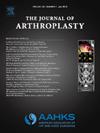Characteristics of Osteonecrosis of the Femoral Head After COVID-19 Compared to Corticosteroid-Associated Osteonecrosis of the Femoral Head: A Multicenter, Large Database Study in Japan
IF 3.8
2区 医学
Q1 ORTHOPEDICS
引用次数: 0
Abstract
Background
Coronavirus disease 2019 (COVID-19) has been associated with systemic complications in addition to respiratory symptoms, including potential musculoskeletal disorders, such as osteonecrosis of the femoral head (ONFH). The aim of this study was to determine the difference between ONFH after COVID-19 and corticosteroid-associated ONFH using a large-scale ONFH database.
Methods
We analyzed 5,371 registered ONFH patients from a large multicenter Japanese database, identifying 20 patients (32 hips) who developed ONFH after COVID-19 (COVID-19 group). These were compared with 693 corticosteroid-associated ONFH patients (1,197 hips) from 2020 to 2024 who were unrelated to COVID-19 (corticosteroid group). Patient demographics, Japanese Investigation Committee (JIC) type and stage classification, duration of corticosteroid administration, maximum daily dose, and corticosteroid-pulse therapy were assessed.
Results
Patients in the COVID-19 group had significantly shorter corticosteroid administration (2.3 ± 2.9 versus 44.9 ± 65.1 months, P < 0.0001) and lower maximum daily dosages (28.1 ± 19.8 versus 53.2 ± 117.3 mg, P = 0.011). Fewer patients received pulse therapy (15.0% versus 49.4%, P = 0.0025). The COVID-19 group showed a notable men predominance (P = 0.008), and the proportion of JIC type C2 was high (P = 0.027).
Conclusions
Osteonecrosis of the femoral head after COVID-19 showed the features of lower corticosteroid use, higher prevalence in men, and higher rate of JIC type C2 compared to corticosteroid-associated ONFH, underscoring the potential impact of COVID-19-related thrombotic pathways. Physicians should be aware of these features and perform appropriate tests as early as possible in COVID-19 patients who have musculoskeletal symptoms, even if corticosteroid use is low.
与皮质类固醇相关的股骨头坏死相比,新冠肺炎后股骨头坏死的特征:日本的一项多中心、大数据库研究
背景:2019冠状病毒病(COVID-19)除了呼吸道症状外,还与全身并发症有关,包括潜在的肌肉骨骼疾病,如股骨头骨坏死(ONFH)。本研究的目的是通过大型ONFH数据库确定COVID-19后ONFH与皮质类固醇相关的ONFH之间的差异。方法:我们分析了来自日本大型多中心数据库的5371例登记的ONFH患者,确定了20例(32髋)在COVID-19后发生ONFH (COVID-19组)。将这些与2020年至2024年与COVID-19无关的693例皮质类固醇相关的ONFH患者(1197例髋)(皮质类固醇组)进行比较。评估患者人口统计学、日本调查委员会(JIC)类型和分期、皮质类固醇给药时间、最大日剂量和皮质类固醇脉冲治疗。结果:COVID-19组患者皮质类固醇给药时间明显缩短(2.3±2.9)。(44.9±65.1个月,P < 0.0001),最大日给药剂量低于(28.1±19.8个月)。53.2±117.3 mg, P = 0.011)。接受脉冲治疗的患者较少(15.0%)。49.4%, p = 0.0025)。COVID-19组男性明显占优势(P = 0.008), JIC C2型比例较高(P = 0.027)。结论:与皮质类固醇相关的ONFH相比,COVID-19后股骨头骨坏死表现出皮质类固醇使用较少、男性患病率较高、JIC C2型发生率较高的特点,强调了COVID-19相关血栓形成途径的潜在影响。医生应该意识到这些特征,并尽早对有肌肉骨骼症状的COVID-19患者进行适当的检查,即使皮质类固醇的使用量很低。
本文章由计算机程序翻译,如有差异,请以英文原文为准。
求助全文
约1分钟内获得全文
求助全文
来源期刊

Journal of Arthroplasty
医学-整形外科
CiteScore
7.00
自引率
20.00%
发文量
734
审稿时长
48 days
期刊介绍:
The Journal of Arthroplasty brings together the clinical and scientific foundations for joint replacement. This peer-reviewed journal publishes original research and manuscripts of the highest quality from all areas relating to joint replacement or the treatment of its complications, including those dealing with clinical series and experience, prosthetic design, biomechanics, biomaterials, metallurgy, biologic response to arthroplasty materials in vivo and in vitro.
 求助内容:
求助内容: 应助结果提醒方式:
应助结果提醒方式:


